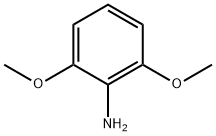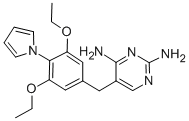5-[(4-amino-3,5-dimethoxy-phenyl)methyl]pyrimidine-2,4-diamine
- CAS NO.:56066-19-4
- Empirical Formula: C13H17N5O2
- Molecular Weight: 275.31
- SAFETY DATA SHEET (SDS)
- Update Date: 2022-12-21 16:56:50
![5-[(4-amino-3,5-dimethoxy-phenyl)methyl]pyrimidine-2,4-diamine Structural](https://img.chemicalbook.in/CAS/GIF/56066-19-4.gif)
What is 5-[(4-amino-3,5-dimethoxy-phenyl)methyl]pyrimidine-2,4-diamine?
Originator
Aditeren ,Onbio Inc.
Manufacturing Process
A solution of 6.9 g of sodium in 1 liter of absolute ethanol were treated with
54 g of guanidine carbonate and 31.0 g of 4-amino-α-(anilinemethylene)-3,5-
dimethoxyhyrocinnamic acid nitrile and boiled under reflux for 20 hours. 500
ml of water were added and the alcohol was removed in vacuum. After
standing at room temperature for 2 hours, the crystallized 2,4-diamino-5-(4-
amino-3,5-dimethoxybenxyl)pyrimidine was filtered off under suction, washed
with water and recrystallised from methanol; melting point 215°-216°C.
The starting material was prepared as follows:
13.8 g of sodium were dissolved in 900 ml of methanol. To this solution were
added 46.8 g of 3-hydroxy-5-keto-3-cyclohexenecarboxylic acid. This mixture
was stirred, held between -4° and -8°C by means of a cooling bath and
treated during 30 minutes with a phenyl-diazonium chloride solution [prepared
from 27.9 g of aniline, 450 ml of water, 72 ml of concentrated hydrochloric
acid and 21.0 g of sodium nitrite in 90 ml of water]. The resulting mixture
was stirred for a further 1 hour at -5°C to -10°C. The deposited, red reaction
product was filtered off under vacuum and washed with ca 1000 ml of water.
There was obtained 3-hydroxy-5-keto-4-phenyl-azo-3-cyclohexenecarboxylic
acid of melting point 218°C.
60 g of 3-hydroxy-5-keto-4-phenyl-azo-3-cyclohexenecarboxylic acid, 200 ml
of methanol, 1200 ml of benzene and 5 g of p-toluenesulphonic acid were
boiled together under reflux on a water separator for 18 hours. After cooling,
the solution was washed with 500 ml of a 5% sodium bicarbonate solution,
then washed with water, dried and evaporated. The residue was dissolved in
ethyl acetate and purified on an aluminum oxide column [500 g; activity stage
I]. After evaporation of the ethyl acetate and recrystallisation of the residue
from benzene/petroleum ether, there was obtained 3-hydroxIy-5-keto-4-
phenyl-azo-3-cyclohexenecarboxylic acid methyl ester as a solid of melting
point 144°C.
54.8 g of 3-hydroxy-5-keto-4-phenyl-axe-3-cyclohexenecarboxylic acid methyl
ester, 12.0 g of acetamide and 2.0 g of bromosuccinimide were stirred in 600
ml of chloroform and treated dropwise with 32.0 g of bromine in 400 ml of
chloroform [the reaction temperature being held below 35°C]. The separation
of acetamide hydrobromide soon began. The mixture was stirred for a further
30 minutes at room temperature, the acetamide hydrobromide filtered off and
the filtrate evaporated to dryness. The residue was taken up in a small
amount of ethanol, filtered off under vacuum and washed with ethanol. There
was obtained 3,5-dihydroxy-4-phenylazobenzoic acid methyl ester of melting
point 216°-218°C.
A mixture of 27.2 g of 3,5-dihydroxy-4-phenylazobenzoic acid methyl ester,
150 ml of methanol and 64 g of dimethyl sulfate was treated during 45
minutes with a solution of 23 g of sodium hydroxide in 50 ml of water while
stirring. Care was taken that the temperature did not exceed 55°C by means
of a cooling bath. The mixture was stirred at room temperature for a further 1
hour, cooled with ice water, filtered off under vacuum and recrystallized from
400 ml of ethanol. Red crystals of 3,5-dimethoxy-4-phenylazobenzoic acid
methyl ester were obtained; melting point 130°-132°C.
12 g of 3,5-dimethoxy-4-phenylazobenzoic acid methyl ester were dissolved in
400 ml of ethanol and, after the addition of 0.80 g of palladium on carbon,
hydrogenated under atmospheric pressure and at room temperature. With
slight warming, 2 moles of hydrogen were taken up during 1.5 hours. The
catalyst was filtered off and the filtrate concentrated in vacuum. The resulting
aniline was distilled off with steam. After cooling, the 4-amino-3,5-
dimethoxybenzoic acid methyl ester which remained as an aqueous
suspension, was filtered off under vacuum, dried and recrystallised from
cyclohexane; melting point 115°-116°C.
A suspension of 214 g of dimethylsulphone and 78.2 g of sodium hydride
(50% dispersion in oil) in 400 ml of absolute dimethyl sulfoxide was stirred at
50°C under nitrogen and with exclusion of moisture for 3 hours. The mixture
was cooled to 30°C, whereupon 137 g of 4-amino-3,5-dimethoxybenzoic acid
methyl ester were added, the temperature rising to 50°C. After stirring under
nitrogen and at room temperature for ca 1 hour, the resulting mixture was left
to stand for 3 hours and then dissolved in 2 liters of water under addition of
ice. The solution was adjusted to pH 6-7 with glacial acetic acid. After stirring
under ice-cooling for 1 hour, the crystallized 4'-amino-3',5'-dimethoxy-2-
methylsulfonyl-acetophenone was filtered off under suction, washed with
water, dried and recrystallised from ethyl acetate; MP: 166°-167°C.
A suspension of 123 g of 4'-ammo-3',5'-dimethoxy-2-methylsulphonyl-acetophenone and 68 g of sodium borohydride in 1.5 liters of alcohol was
stirred at room temperature for 20 hours. The suspension was diluted with 1.5
liters of water. The alcohol was evaporated in vacuum and the resulting 4-
amino-3,5-dimethoxy-α-(methylsulfonylmethyl)benzyl alcohol was filtered off
under suction, washed with water and dried; melting point 178°-179°C.
A mixture of 8.64 g of sodium methylate, 14.6 g of p-anilinepropionitrtile and
22.0 g of 4-amino-3,5-dimethoxy-α-(methylsulfonylmethyl)benzyl alcohol in
50 ml of absolute dimethyl sulfoxide was stirred at 50°C for 1 hour under
nitrogen and with the exclusion of moisture. The solution was poured into 500
ml of ice-water and the resulting emulsion was extracted with two 500 ml
portions of ethyl acetate. The ethyl acetate extracts were washed with two
250 ml portions of water, dried over magnesium sulfate and evaporated in
vacuum. The residue was dissolved in 60 ml ethyl acetate. After standing at
room temperature for 20 hours, the crystallized 4-amino-α-
(anilinemethylene)-3,5-dimethoxyhydrocinnamic acid nitrile was filtered off
under suction, washed with a small amount of ethyl acetate and dried; MP:
150°-151°C.
Therapeutic Function
Diuretic
Safety information for 5-[(4-amino-3,5-dimethoxy-phenyl)methyl]pyrimidine-2,4-diamine
New Products
(S)-3-Aminobutanenitrile hydrochloride 4-Methylphenylacetic acid N-Boc-D-alaninol N-BOC-D/L-ALANINOL Tert-butyl bis(2-chloroethyl)carbamate 3-Morpholino-1-(4-nitrophenyl)-5,6-dihydropyridin- 2(1H)-one Furan-2,5-Dicarboxylic Acid Tropic acid 1-Bromo-3,5-Di-Tert-Butylbenzene S-2-CHLORO PROPIONIC ACID ETHYL ISOCYANOACETATE 2-Bromo-1,3-Bis(Dimethylamino)Trimethinium Hexafluorophosphate 4-IODO BENZOIC ACID 3-NITRO-2-METHYL ANILINE 1-(2,4-DICHLOROPHENYL) ETHANAMINE (2-Hydroxyphenyl)acetonitrile 4-Bromopyrazole 2-(Cyanocyclohexyl)acetic acid 4-methoxy-3,5-dinitropyridine 1-(4-(aminomethyl)benzyl)urea hydrochloride 2-aminopropyl benzoate hydrochloride diethyl 2-(2-((tertbutoxycarbonyl)amino) ethyl)malonate tert-butyl 4- (ureidomethyl)benzylcarbamate Ethyl-2-chloro((4-methoxyphenyl)hydrazono)acetateRelated products of tetrahydrofuran

![5-[(4-amino-3,5-dimethoxy-phenyl)methyl]pyrimidine-2,4-diamine](https://img.chemicalbook.in/CAS/GIF/56066-19-4.gif)



You may like
-
 2033-24-1 98%View Details
2033-24-1 98%View Details
2033-24-1 -
 42831-50-5 5-METHYLISOXAZOLE-4-CARBOXYLIC ACID 98%View Details
42831-50-5 5-METHYLISOXAZOLE-4-CARBOXYLIC ACID 98%View Details
42831-50-5 -
 1975-50-4 98%View Details
1975-50-4 98%View Details
1975-50-4 -
 2-HYDROXY BENZYL ALCOHOL 98%View Details
2-HYDROXY BENZYL ALCOHOL 98%View Details
90-01-7 -
 2-Chloro-1,3-Bis(Dimethylamino)Trimethinium Hexafluorophosphate 221615-75-4 98%View Details
2-Chloro-1,3-Bis(Dimethylamino)Trimethinium Hexafluorophosphate 221615-75-4 98%View Details
221615-75-4 -
 61397-56-6 CIS BROMO BENZOATE 98%View Details
61397-56-6 CIS BROMO BENZOATE 98%View Details
61397-56-6 -
 14714-50-2 (2-Hydroxyphenyl)acetonitrile 98+View Details
14714-50-2 (2-Hydroxyphenyl)acetonitrile 98+View Details
14714-50-2 -
 118753-70-1 98+View Details
118753-70-1 98+View Details
118753-70-1